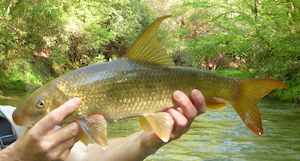- Conservation of Georgia's Fishes
- Identifying Georgia's Fishes
- Species Profiles and Range Maps for Georgia’s Rare Freshwater Fishes
- Fishes of Georgia Flickr Photo Gallery
- Georgia’s Freshwater Game Fishes
- Trispot Coloring Book
Georgia’s Amazing Freshwater Fish Fauna
Georgia ranks third in the nation for the number of native freshwater fishes; only Alabama and Tennessee have more species. About 265 species are considered native to the state, which includes 245 described species and 20 species that have not yet been formally described by ichthyologists. An additional 19 species are not native to the state but have been introduced through intentional stockings or accidental releases. Georgia’s freshwater fishes are arranged in 27 different families of fishes, which are groups of closely related species. In order of decreasing diversity, the most diverse Georgia freshwater fish families are the minnows (Leuciscidae, formerly Cyprinidae), darters (Percidae), sunfishes (Centrarchidae), suckers (Catostomidae), and Catfishes (Ictaluridae). Five described species are endemic to the state of Georgia and occur nowhere else in the world: Ocmulgee shiner (Cyprinella callisema), Altamaha shiner (Cyprinella xaenura), Chattahoochee sculpin (Cottus chattahoochae), Etowah darter (Etheostoma etowahae) and Cherokee darter (Etheostoma scotti). Dozens more are nearly endemic and have the majority of their range within the boundaries of our state.
Georgia’s fishes are amazing not just for their taxonomic diversity, but also for their fascinating variety of sizes, color patterns, life histories, and behaviors. On the puny side are the least killifish (Leptolucania ommata) and pygmy killifish (Heterandria formosa), both which max out around an inch in length and several species of pygmy sunfishes (Elassoma spp.) which grow only slightly longer. At the opposite end of the extreme is Georgia’s longest fish, the Atlantic sturgeon (Acipenser oxyrinchus), which may exceed 8 feet and is sometimes observed leaping out of the water in large coastal rivers. Atlantic sturgeon are representative of a group of highly migratory species that migrate hundreds or perhaps thousands of miles between feeding and breeding areas; other highly migratory species include American eels, striped bass, several species of shad, and mountain mullet. While most of our fishes do not make these epic journeys to complete their life cycle, movement between feeding, breeding, and refuge habitats has been shown to be important for even small species like minnows and darters. For example, the trispot darter (Etheostoma trisella) is known to migrate from large river feeding habitats into the tiniest headwater streams for spawning in late winter and early spring.
The diversity of breeding habitats and behaviors exhibited by Georgia fishes is amazing, but also important to know for management and conservation efforts. Most fishes are broadcast spawners that lay large numbers of eggs and invest no-parental care in their offspring, but there are many interesting variations and exceptions to this pattern. For example, male bluehead chubs and river chubs are known to construct a spawning nest by moving gravel and small pebbles into a mound. While this nest-building behavior is fascinating in its own right, these nests also provide spawning habitat for a variety of other minnow species. These nest-associating minnows are some of the most colorful fishes in our streams and are easily observed from stream banks in late spring to early summer throughout central and North Georgia. Another interesting example is catfishes (family Ictaluridae), which nest under cavities formed by rocks and logs. Male and female catfishes may contribute to parental care, which includes nest site preparation, fanning of the eggs with their fins, and guarding of the eggs and larvae. Browse the photos below to see a few more examples of Georgia’s amazing freshwater fishes.
This video shows a group of Alabama shiners (Cyprinella callistia) exhibiting spawning behavior around a rock crevice. The males are the brightly colored animals with bluish-white patches on their heads and red tails. The white patches are formed by tubercles (tiny horns or bumps composed of Keratin), which may function in combat between rival males and in signaling reproductive status to females. A few females (with a gold lateral stripe but without tubercles or distinctive coloration) can be seen darting into the crevice. The male and female will swim along the crevice and deposit eggs and sperm (you cannot see this in the video, but it is probably going on). Other males may also make solo runs along the crevice in an attempt to fertilize some of the eggs. Crevice spawning, which is characteristic of minnows in the genus Cyprinella, is considered an adaption to reduce predation on eggs. Photo and video by Brett Albanese (GADNR).
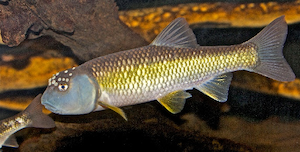
Male bluehead chub (Nocomis leptocephalus), a minnow species that constructs a gravel mound for spawning.
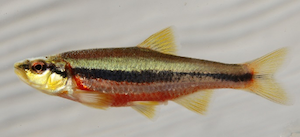
Yellowfin Shiner (Notropis lutipinnis) is a nest-associating minnow that lays eggs in chubs' nests.

Stoneroller (Campostoma spp) grazes on algae, transferring energy to predators.
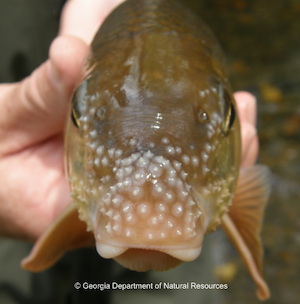
Golden Redhorse (Moxostoma erythrurum) is one of Georgia's 20+ sucker species.
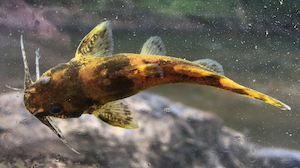
Frecklebelly Madtom (Noturus munitus) is a rare species found in north Georgia rivers.
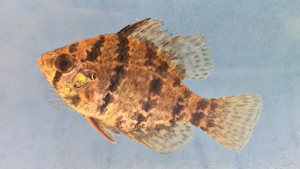
Blackbanded Sunfish (Enneacanthus chaetodon) is associated with aquatic vegetation in blackwater rivers.
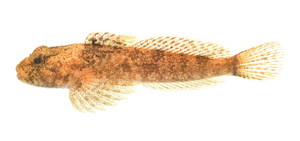
Sculpins (Cottus sp.) inhabit cold, rocky streams and have large mouths for hunting.
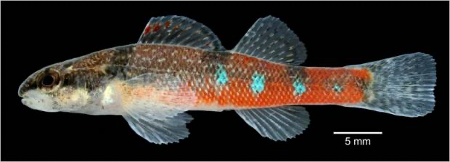
Male trispot darter (Etheostoma trisella) migrates for spawning, requiring habitat protection.
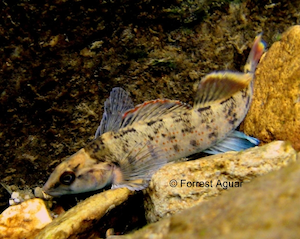
Greenbreast darter (Etheostoma jordani) thrives in fast-moving, rocky streams.
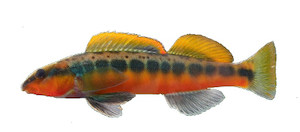
Tangerine Darter (Percina aurantiaca) is only found in Georgia's Toccoa River.

Freshwater Drum (Aplodinotus grunniens) is the only drum species occurring in freshwater.
Fish Conservation
While Georgia’s fish fauna is very diverse, it is also highly threatened. Fifty-eight species are considered imperiled and are protected under Georgia’s Endangered Wildlife Act; 10 of these fishes are also protected under the U.S. Endangered Species Act. Five species are considered extirpated from the state and may no longer occur in Georgia waters: Gulf sturgeon (Acipenser oxyrinchus desotoi), the spotfin chub (Erimonax monachus), harelip sucker (Moxostoma lacerum), yellowfin madtom (Noturus flavipinnis) and the ashy darter (Etheostoma cinereum). Our fish fauna is threatened by a variety of factors including urbanization, poor land use practices associated with historic and current agricultural and forestry operations, reservoirs, chemical pollution, climate change and invasive species.
Find out more at Conserving Georgia’s Aquatic Species.
You can also create a custom list of Georgia fish species that are listed under the U.S. Endangered Species Act or the Georgia Endangered Wildlife Act, or designated as a conservation priority under Georgia’s State Wildlife Action Plan by visiting our Rare Fishes List on the Georgia Biodiversity Portal. You can also search your local watershed and other geographic areas by visiting Rare Fishes by Location on the Georgia Biodiversity Portal.
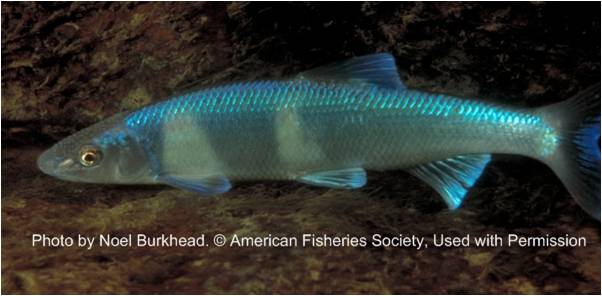
The spotfin chub (Erimonax monachus), one of five fish species that are considered extirpated from Georgia waters. Photo by Noel Burkhead. Image may be subject to copyright.
Identification of Georgia's Freshwater Fishes
Our diverse fish fauna makes fish identification in Georgia challenging, even for ichthyologists. If you have a good photograph of a fish that you caught or observed underwater, you can usually get an approximate identification using a combination of photos and range maps. Our Fishes of Georgia Photo Gallery on Flickr is organized by fish family and has many photos of freshwater and coastal fishes that can be viewed on your computer or with the Flickr app on your smartphone.
Our Rare Fishes page on the Georgia Biodiversity Portal has photos and species descriptions for protected species as well as species designated as a conservation priority under Georgia’s State Wildlife Action Plan. While it is illegal to capture these species without a permit, they are encountered by researchers and fish watchers in some of our clear North Georgia rivers. An electronic copy of a Field Guide to Fishes of the Conasauga River system can be downloaded.
Additional taxonomic references are listed below.
Taxonomic Resources
- Boschung, H. T. and R. L. Mayden. 2004. The fishes of Alabama. Smithsonian Institute, Washington. 736pp.
- Etnier, D. A. and W.C. Starnes. 1993. The fishes of Tennessee. Univ. Tennessee Press, Knoxville. 681pp.
- Jenkins, R. E. and N. M. Burkhead. 1993. Freshwater fishes of Virginia. Am. Fish. Soc., Bethesda. 1079pp.
- Marcy, B. C., Jr., D. E. Fletcher, F. D. Martin, M. H. Paller and M. J. M. Reichert. 2005. Fishes of the middle Savannah River Basin: with emphasis on the Savannah River Site. The University of Georgia Press. 462 pp.
- Mettee, M. F., P. E. O'Neil and J. M. Pierson. 1996. Fishes of Alabama and the Mobile Basin. Oxmoor House, Birmingham. 820pp.
- North American Native Fishes Association (NANFA). This webpage features excellent photographs of fishes in the member photo gallery and also has a link to a fish snorkeling guide. NANFA also organizes fish sampling and outreach events in Georgia. Available online at http://www.nanfa.org/
- Rhode, F.C., R.G. Arndt, J.W. Foltz, and J.M. Quattro. 2009. Freshwater fishes of South Carolina. The University of South Carolina Press, Columbia. 430pp.
- Robins, R.H., L.M. Page, J.D. Williams, Z.S. Randall, and G.E. Sheehy. 2018. Fishes in the fresh waters of Florida: an identification guide and atlas. University of Florida Press. 467pp.
- Ross, S.T. 2000. Inland fishes of Mississippi. Mississippi Department of Wildlife, Fisheries, and Parks, Jackson. 624pp.
- Skelton, C.E. and B. Albanese 2006. Field guide to fishes of the Conasauga River system. U.S. Forest Service Manual, Gainesville, GA. 251pp. Available online.
- Snelson, F.F Jr., T.J. Krabbenhoft, and J.M. Quattro. 2009. Elassoma gilberti, a new species of pygmy sunfish (Elassomatidae) from Florida and Georgia. Bulletin Florida Museum Natural History Vol 48(4):119-144.
- Straight, C.A., B. Albanese, and B.J. Freeman. Fishes of Georgia Website, Georgia Museum of Natural History.
- Williams, J.D., D. A. Neely, S.J. Walsh, and N.M. Burkhead. 2007. Three new percid fishes from the Mobile Basin drainage of Alabama, Georgia, and Tennessee. Zootaxa 1549: 1–28.
This page was last updated July 2020. If you encounter problems with this page or would like to suggest changes or additions, please send an email to brett.albanese@dnr.ga.gov.
